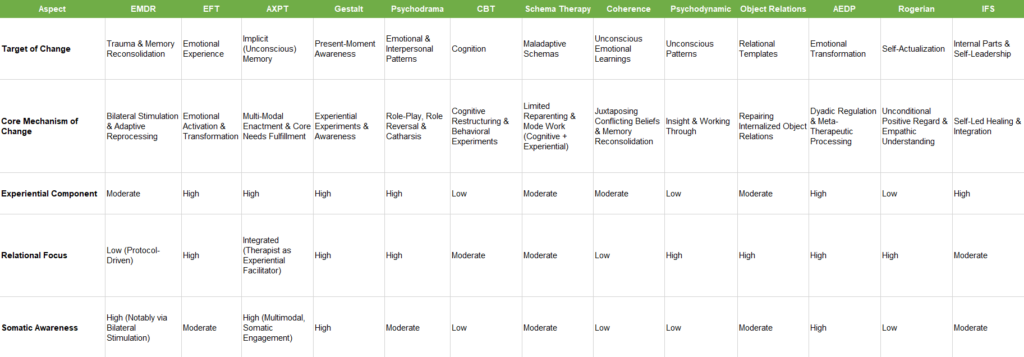Therapy is a journey that helps people improve their lives. It understands that each person has their background, challenges, and goals. Over the years, mental health professionals have developed different types of therapy. Each type offers tools to help clients manage emotional pain, heal from trauma, change negative thoughts, and build healthier relationships.
We provide an overview of popular psychotherapy methods. At Wellspring Counselling & Psychotherapy Inc., we mainly use Process-Experiential, EMDR, EFT, and CorMorphosis™ Psychotherapies. However, we also include elements from other methods to meet each person’s unique needs.
Table of Contents
Eye Movement Desensitization and Reprocessing (EMDR)
Target of Change: Traumatic Memories and Associated Distress
EMDR is a structured, phase-based therapy often used for Post-Traumatic Stress Disorder (PTSD) and other trauma-related concerns.
Core Mechanism of Change:
- Adaptive Information Processing: EMDR (Eye Movement Desensitization and Reprocessing) therapy helps people who have experienced trauma. The idea is that trauma stays in the brain without being processed. In this treatment, clients recall traumatic memories while engaging in activities stimulating both sides of their bodies, such as moving their eyes, tapping, or listening to sounds. This technique helps change how the brain stores those memories, making them less intense. It also supports healthier beliefs about oneself and the world.
Unique Feature:
- It helps reduce the emotional impact of distressing memories. It can quickly relieve symptoms related to trauma.
Example
A client remembers a car accident and uses techniques to help them relax. This process gradually lessens the emotional and physical pain of the memory and helps them feel safer.
Emotion-Focused Therapy (EFT)
Target of Change: Emotional Experience
Dr. Leslie Greenberg and his team developed EFT or Emotionally Focused Therapy. It focuses on emotions as the main influences on how people act and change their lives.
Core Mechanism of Change:
- Emotional Transformation: By accessing, deepening, and transforming core emotional experiences, clients can learn to turn negative feelings like shame or fear into positive ones, such as self-compassion and empowerment.
- Emotion Schemes: Understanding and changing emotional patterns can help clients improve their relationships with themselves and others in lasting ways.
Unique Features:
- Experiential techniques (e.g., two-chair work) help clients resolve internal conflicts in real-time.
- This approach focuses on building strong connections and healing relationships. It is suitable for couples or individuals who are dealing with relationship problems.
Example:
A client who feels shame from critical parenting discovers deep sadness. Through emotional freedom techniques (EFT), they change their shame into self-compassion, which leads to better relationships and improved self-esteem.

CorMorphosis™ Psychotherapy
Target of Change: Implicit Memory
CorMorphosis™ Psychotherapy aims to change deep, hidden habits through hands-on activities, experiential reenactments and multimodal engagement.
Core Mechanism of Change:
- Multimodal Enactment & Corrective Experiences: Clients revisit difficult experiences from the past or present, which can bring up strong emotions, thoughts, and physical sensations. During these experiences, new memory connections form in the brain by meeting basic needs like safety, belonging, and independence. This helps change how clients see themselves and interact with others.
- Somatic Integration: Moving the body paying attention to sensations and emotions, helps us develop healthier responses in our memories. Engaging both physical movement and thinking leads to better emotional understanding and learning.
Unique Features:
- Explicit emphasis on identifying and meeting core needs through corrective experiences.
- Integrates emotional, cognitive, somatic, and sensory components in a dynamic, experiential framework.
Example:
A client who felt dismissed as a child acts out a moment where they seek comfort. They work through their unmet needs, imagine getting empathy, and practice expressing their needs directly. Over time, their feelings change from “I’m unimportant” to “My needs deserve attention and respect.”
Gestalt Therapy
Target of Change: Present-Moment Awareness and Integrative Experience
Gestalt Therapy believes that being aware of ourselves can help us heal. It encourages clients to connect different parts of themselves that may feel separate.
Core Mechanism of Change:
- Here-and-Now Focus: Clients can increase their awareness of their thoughts, feelings, and body sensations through the empty-chair technique, guided dialogues, and role-plays. This greater awareness helps them identify “unfinished business” and make positive changes.
- Personal Responsibility: Clients learn to take responsibility for their choices and feelings. This allows them to express themselves honestly.
Unique Feature:
- Emphasizes embodiment, spontaneity, and authenticity in the present moment.
Example:
A client uses the empty-chair exercise to express unresolved anger toward a parent. By acting out both sides of the conversation, they heal old emotional wounds and better understand themselves.
Psychodrama
Target of Change: Emotional and Interpersonal Patterns
Psychodrama therapy uses role-play and drama to help people explore their inner conflicts and relationships. It also helps find possible solutions to these issues.
Core Mechanism of Change:
- Enactment & Role Reversal: Clients act out personal stories, taking on different roles to better understand their and others’ motivations.
- Catharsis & Integration: The process often helps clients express their feelings and releases hidden emotions. This emotional release, known as “catharsis,” also allows clients to try new ways of behaving or solving problems. They can then use these insights in their everyday lives.
Unique Features:
- Encourages creativity and spontaneity, often harnessing group dynamics to amplify insights.
- It can be adapted for individual sessions if group work is not feasible.
Example:
A client having a conflict at work acts out a tense conversation with a coworker, taking on both roles. This change in perspective helps build empathy, lowers defensiveness, and shows better ways to communicate.
Cognitive Behavioral Therapy (CBT)
Target of Change: Cognition
Cognitive Behavioral Therapy (CBT) helps people change unhelpful thoughts, like “I’m a failure” or “People will reject me.” These thoughts can lead to emotional pain and unhelpful actions. CBT focuses on recognizing these thoughts and making them more positive.
Core Mechanism of Change:
- Cognitive Restructuring: You can change and improve your automatic thoughts and core beliefs. As your beliefs change, your emotions and actions will become more positive and helpful.
- Behavioural Experiments: Clients test new beliefs or behaviours in real-life situations. This helps them gather evidence that supports more balanced thinking and acting.
Unique Features:
- Structured, short-term, and goal-oriented; often includes homework and measurable outcomes.
- Provides practical tools (thought records, coping strategies) for ongoing self-help.
Example:
A client with social anxiety learns to recognize the belief, “Everyone will laugh at me if I speak up.” They challenge this thought and practice speaking in social situations. Over time, they develop a more realistic belief: “Most people are not judging me.” This shift helps reduce their anxiety.
Schema Therapy
Target of Change: Maladaptive Schemas
Schema Therapy addresses deeply entrenched patterns (schemas) shaped in childhood or adolescence.
Core Mechanism of Change:
- Limited Reparenting & Schema Mode Work: The therapist helps clients by providing emotional support in a safe setting. This support addresses needs like care and protection that may not have been met. The therapist also uses techniques to identify and challenge unhelpful thought patterns, aiming to change these patterns for better outcomes.
- Integrative Approach: This method uses cognitive-behavioral therapy (CBT), psychodynamic techniques, and experiential methods. It aims to reduce harmful thought patterns and boost healthy ways of thinking.
Unique Feature:
- This approach looks at how childhood experiences shape our core beliefs. It uses different methods to change these beliefs more deeply than standard cognitive behavioural therapy (CBT).
Example
A client with a “Defective” belief often expects to be rejected. Schema Therapy helps them identify this pattern linked to early criticism. It teaches them better coping strategies and helps them develop a new belief: “I am worthy of acceptance.”
Coherence Therapy
Target of Change: Unconscious Emotional Learnings
Coherence Therapy uncovers hidden emotional truths or insights that support a client’s symptoms—even if they initially seem irrational.
Core Mechanism of Change:
- Memory Reconsolidation Through Juxtaposition: To change an old belief, like “If I’m vulnerable, I’ll be hurt,” you can first recognize it. Then, compare it with a new, positive reality. This process helps rewrite the old beliefs in your brain.
Unique Feature:
- It encourages quick and lasting change by addressing the specific emotional issues causing the problem instead of just managing the symptoms.
Example:
A client afraid of being vulnerable might discover a buried truth from childhood: being open makes them a target for ridicule. When they compare this old belief to their current experiences of feeling safe and accepted, they can experience a profound change that helps them let go of the old belief.
Psychodynamic Therapy
Target of Change: Unconscious Processes Shaped by Early Life Experiences
Psychodynamic Therapy helps people understand how their past experiences affect their present behaviour. It aims to bring unconscious thoughts to awareness so clients can identify and work through feelings and patterns.
Core Mechanism of Change:
- Insight & Working Through: Through free association, dream analysis, and talking about how clients project their feelings onto the therapist, people can understand their hidden conflicts and defences. This process helps them find resolution or integration over time.
- Repetition Compulsion: Recognizing how we repeat familiar relationship patterns can help us develop new and healthier ways to connect with others.
Unique Feature:
- Addressing deep emotional conflicts and personality issues often requires thorough and long-term exploration. This process assists individuals in gaining a better understanding of themselves and in addressing their challenges.
Example:
- A client realizes that their fear of intimacy stems from childhood experiences with emotionally unavailable caregivers. Recognizing these patterns helps alleviate anxiety about forming close relationships and fosters healthier connections.
Object Relations Therapy
Target of Change: Relational Templates Formed in Early Caregiving Relationships
Object Relations Therapy examines how we take in “objects” or significant people and how these mental images affect our current relationships.
Core Mechanism of Change:
Exploration & Repair of Internalized Objects: Clients look at their past relationships to understand how old attachment issues affect their current views of relationships. In therapy, positive relationship experiences help them develop healthier and more realistic views of others.
Unique Feature:
- The therapeutic relationship reflects the client’s internal world and helps create new patterns of trust and closeness.
Example:
A client recognizes that their fear of abandonment stems from inconsistent caregiving. Therapy aids them in understanding the distinction between their past and present experiences. This process allows them to form stable, secure relationships.
AEDP (Accelerated Experiential Dynamic Psychotherapy)
Target of Change: Emotional Transformation
AEDP posits that clients have an innate capacity for resilience and thriving.
Core Mechanism of Change:
- Dyadic Regulation & Experiential Processing: The therapist offers supportive and understanding help so clients can deal with strong emotions like shame and grief without fear. This process helps clients feel less alone and lets them understand their true feelings, which they can change into healthier emotional states.
- Meta-Therapeutic Processing: Thinking about positive changes as they happen helps make these changes last longer.
Unique Feature:
- Focus on healing by using breakthroughs from our sessions to enhance positive change and strengthen self-compassion.
Example:
Focus on healing by using breakthroughs from our sessions to enhance positive change and strengthen self-compassion.
Rogerian Therapy (Person-Centered Therapy)
Target of Change: Self-Actualization
Carl Rogers championed the belief that people naturally desire growth and fulfillment.
Core Mechanism of Change:
- Unconditional Positive Regard, Empathy, and Congruence: The therapist’s genuine acceptance and understanding create a safe space for clients. In this nonjudgmental setting, clients can comfortably explore their thoughts and feelings, helping them bring their “actual self” closer to their “ideal self.”
Unique Feature:
- The therapist focuses on the client’s needs and does not give direct advice. They believe clients can find solutions when they feel accepted and supported.
Example:
A client wrestling with self-doubt feels fully seen and validated. Over time, this positive regard helps them recognize their strengths and pursue authentic life choices.
Internal Family Systems (IFS)
Target of Change: Internal Parts or Sub-Personalities and Self-Leadership
IFS treats the mind as a “family” of “parts,” each with distinct roles (protectors, managers, exiles).
Core Mechanism of Change:
- Self-Led Healing & Integration: Clients connect with their fears and unmet needs by being curious and compassionate. As trust grows, parts that feel excluded can relinquish their burdens, and protective parts can take on less extreme roles.
- Embodied Self: The approach focuses on connecting with the “Self.” This wise and calm inner resource can bring harmony to all parts of ourselves.
Unique Feature:
- Non-pathologizing: All parts aim to protect or help the individual, even if their strategies are problematic.
Example:
A client’s critical “manager” part comes from a fear of failure that started with childhood abandonment. With the Self’s compassion, this manager part becomes gentler, reducing harsh self-talk and promoting self-acceptance.
Comparative Table
This compares different approaches, listed in the order they were presented. Each approach has a primary focus and specific methods and highlights various aspects such as experience, relationships, and physical sensations.

How to Choose the Right Approach
- Identify Your Goals
- Working through trauma? Consider EMDR, AXPT, AEDP, or Psychodrama.
- Seeking deep emotional healing? EFT, AXPT, or AEDP can guide you through intense feelings.
- Want a structured, skill-based approach? CBT or Schema Therapy may fit well.
- Assess Your Comfort with Experiential Methods
- If you’re open to active exploration—role-play, emotional deep dives, somatic work—try Gestalt, Psychodrama, EFT, or IFS.
- If you prefer a directive, time-limited style, CBT or EMDR might be more suitable.
- Evaluate the Level of Emotional Intensity
- Approaches like AEDP, AXPT, and EFT often involve profound emotional engagement; ensure you have support in and out of sessions.
- Others (e.g., Rogerian, CBT) can involve more gradual exploration.
- Consult an Integrative Therapist
- Many clinicians combine methods (e.g., using EMDR for trauma memories alongside CBT for day-to-day stress management) to create a customized approach that addresses each client’s distinct challenges.
Therapeutic approaches offer different ways to heal, grow, and learn about yourself. At Wellspring Counselling & Psychotherapy Inc., we mainly use EMDR, EFT, and AXPT. However, we also use other methods that fit your needs and comfort level. If you want to resolve trauma, EMDR can help. If you’re looking for emotional support, EFT or AXPT may be the right choice. For those interested in hands-on experiences, methods like Psychodrama or Gestalt could work well. There’s a therapy type—or a combination of types—that can meet your needs.
Ready to Begin?
Reach out to Wellspring today to schedule a consultation. Let’s find the therapeutic path that resonates with you and embark on your journey toward well-being.




